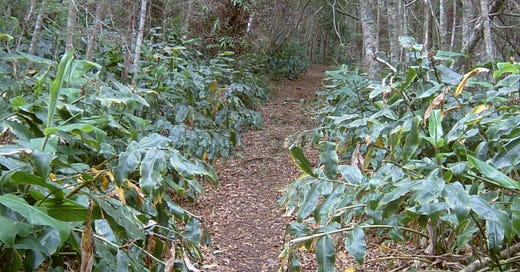An island's warning
How Hawai’i’s environmental problems have helped New Zealand (5 minute preview, 9 minute read)
In my time visiting and working on islands, I’ve learned that they often show different faces, depending on who you are and why you are there. I saw this in the Maldives, where tourists luxuriate on island resorts almost entirely removed from the lives of locals. My experience of these islands was quite different – a frenetic, overcrowded capital and remote outer islands where people were laid back, but also religiously conservative. I saw this in Mauritius, too. It’s another location associated with luxury travel, but I saw environmental devastation.
The Hawai’ian island of Maui was another island showing different faces to different visitors. I was told by my Hawai’ian hosts that it was one of the most expensive and prestigious holiday destinations. I do remember that my accommodation there was at least three times the price of my accommodation in Hilo, on the island of Hawai’i. But I saw none of the tourist attractions – I barely even saw the sea except at a distance. I did, however, get an exclusive, private tour of some sights that tourists don’t get to see. Admittedly, very few tourists would sign up for a tour of Maui’s invasive species, but I was delighted.
Maui is one of the two Hawai’ian islands which are still considered volcanically active. It’s around 500 years since Haleakalā, the larger of the island’s two volcanoes, last erupted, and it may be another 500 before it erupts again. Because it was active recently, Maui hasn’t had much chance to erode away, like the older islands such as O’ahu or Kaua’i. For its size, O’ahu is still high – it’s a little smaller than Rakiura or Stewart Island, yet it’s also around 200 metres higher. But Maui, slightly larger than Rakiura, is three times as high at its highest point.
If I hadn’t been working, I would have gone to the top of Haleakalā to see the unique alpine plants such as the silverswords. These are giant daisies, reminiscent of the giant groundsels I saw on Mt Kenya, although not closely related. However, this was not to be. But, alongside some of the invasive plants, I did see a few of Maui’s treasures. Among them was another relative of a plant I saw on Mt Kenya, a giant lobelia.
If you know the name lobelia, you probably associate it with the garden lobelia, a low-growing plant which usually has blue flowers, although white and various pink and purple shade are available. There are also native species of lobelias, including one I’d love to see in the wild one day, a rare, forest shrub from Northland and various offshore islands. Hawai’i, though, has a lot of lobelias. There are more than 100 species from this group which are native to Hawai’i, with many growth forms. The one I saw was a shrub with fleshy, green flowers reminiscent of a triffid, if you saw the BBC series in the 1980s.
I saw my giant lobelia in a patch of forest which was being invaded by wild ginger – the same wild ginger which is so troublesome in warmer parts of New Zealand. There are actually several wild ginger species, but the most common and most invasive is emblematic of Hawai’i’s complicated relationship with its invasive plants. It’s native to the Himalayas, but in most places it grows it is called kāhili ginger, which is not a Himalayan name. Kāhili is a Hawai’ian word for a feathered staff which was a symbol of the Hawai’ian nobility. The plant acquired a Hawai’ian name because it is so prevalent there. Unfortunately, it’s one of those plants that doesn’t share space well. It can fill up the undergrowth of a forest and nothing much else can grow through it. Its massive root system covers the ground and it can dominate the undergrowth of a forest to the exclusion of all the native plants.
One of the most important ways that it spreads is by people dumping the masses of roots. It might seem like a nice plant for the garden, with its exotic flowers and their intoxicating perfume, but when it gets out of hand, it often gets dug out and tipped over a bank, out of sight and out of mind. Just like the tradescantia I’m working on in my local park, from there it spreads into the forest. To try and curtail this, it’s one of the species which is now illegal to sell, propagate or distribute in New Zealand. This ban has been imposed with the agreement of our nursery industry, who are willing to be part of the solution rather than the problem. In Hawai’i, though, you can still find kahili ginger marketed as a “symbol of Hawai’ian royalty” and “100% authentically Hawai’ian”.
The Hawai’ians I met were profoundly envious of New Zealand’s arrangement to prohibit certain plants from being sold. Admittedly, these were almost exclusively people working on preserving Hawai’i’s unique species, so they were concerned about the invasive species which threatened these species. But I do think they were justified, because as far as I know, this arrangement is unique.
Known as the National Pest Plant Accord, it is an agreement which involves the Ministry for Primary Industries, the Department of Conservation, councils and the New Zealand Plant Producers Incorporated, the industry group which represents plant growers. I was involved with this agreement on and off for nearly 20 years, and I’m proud of what it has been able to achieve. The end result is that when I go shopping for plants in my garden, I’m not appalled to see plants which I know are a serious problem such as kahili ginger.





